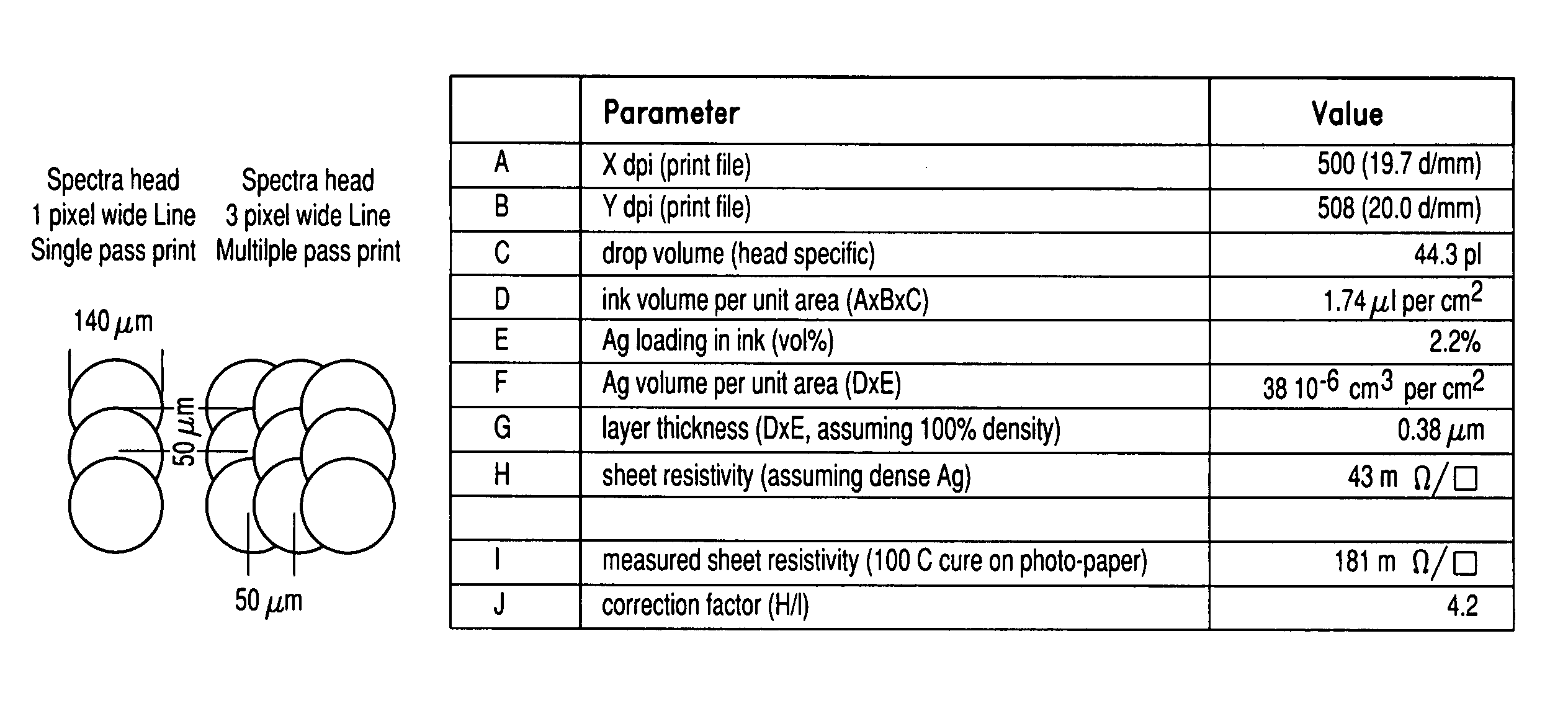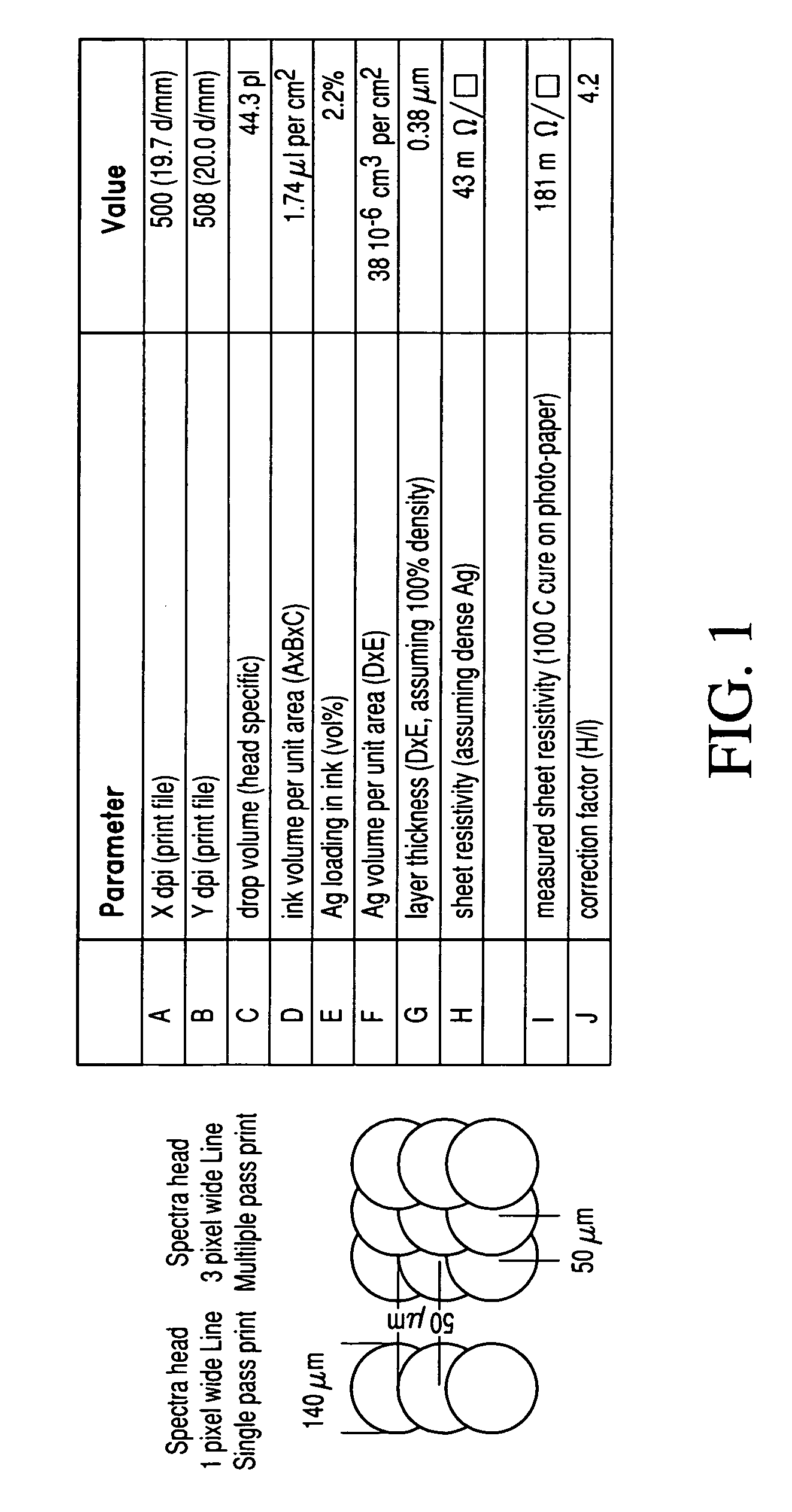Metal nanoparticle compositions
a technology of metal nanoparticles and compositions, applied in the direction of chemical vapor deposition coating, non-conductive materials with dispersed conductive materials, inks, etc., can solve the problems of insufficient approaches to produce well-defined features with good electrical properties, low viscosity compositions are not as well developed as high-viscosity compositions, etc., to achieve good electrical and/or mechanical properties, and low processing (curing).
- Summary
- Abstract
- Description
- Claims
- Application Information
AI Technical Summary
Benefits of technology
Problems solved by technology
Method used
Image
Examples
example 1
Preparation of Silver Nanoparticles Carrying PVP Thereon
[0286] In a mixing tank a solution of 1000 g of PVP (M.W. 10,000, Aldrich) in 2.5 L of ethylene glycol is prepared and heated to 120° C. In a second mixing tank, 125 g of silver nitrate is dissolved in 500 ml of ethylene glycol at 25° C. These two solutions are rapidly combined (within about 5 seconds) in a reactor, in which the combined solutions (immediately after combination at a temperature of about 114° C.) are stirred at 120° C. for about 1 hour. The resultant reaction mixture is allowed to cool to room temperature and about 0.25 L of ethylene glycol is added thereto to replace evaporated ethylene glycol. This mixture is stirred at high speed for about 30 minutes to resuspend any particles that have settled during the reaction. The resultant mixture is transferred to a mixing tank where 12 L of acetone and about 1 L of ethylene glycol are added. The resultant mixture is stirred thoroughly and then transferred to a centri...
example 2
Effect of PVP Molecular Weight on Resistivity and Curing Temperature
[0295] Silver nanoparticles can be synthesized using 58,000 g / mol PVP using a process substantially the same as the process used to synthesize silver nanoparticles using 10,000 g / mol PVP by mixing a PVP / ethylene glycol solution with a silver nitrate / ethylene glycol solution. Once the reaction is complete, 250 mL of ethylene glycol is mixed into the reaction solution after cooling down. The resulting solution is equally divided into five 4-L Nalgene® bottles. 200 mL of ethylene glycol and 3 L of acetone are added to each plastic bottle. The bottles are sealed with lids and shaken up to create a black precipitate suspension in the solvent mixture. The suspensions are transferred to centrifuge bottles and centrifuged at 2,200 RPM for 10 minutes. The clear, light orange supernatants are discarded to leave behind a reflective, silver cake. More black suspension is added to the same bottles and the separation steps are r...
example 3
Preparation and Testing of Composition for Ink-Jet Printing
[0299] Silver nanoparticles prepared according to the process described in Example 1 (ranging from about 30 nm to about 50 nm in size) are suspended in a solvent mixture composed of, in weight percent based on the total weight of the solvent mixture, 40% of ethylene glycol, 35% of ethanol and 25% of glycerol to produce an ink for ink-jet printing. The concentration of the silver particles in the ink is 20% by weight.
[0300] The ink had the following properties:
Viscosity* (22° C.)14.4cPSurface tension** (25° C.)31dynes / cmDensity1.24g / cc
*measured at 100 rpm with a Brookfield DVII+ viscometer (spindle no. 18)
**measured with a KSV Sigma 703 digital tensiometer with a standard Du Nouy ring method
[0301] The ink is chemically stable for 6 months, some sedimentation occurring after 7 days at room temperature.
[0302] Printing and Properties of Printed Features
[0303] A Spectra SE 128 head (a commercial piezo ink-jet head) is loa...
PUM
| Property | Measurement | Unit |
|---|---|---|
| particle size | aaaaa | aaaaa |
| particle size | aaaaa | aaaaa |
| particle size | aaaaa | aaaaa |
Abstract
Description
Claims
Application Information
 Login to View More
Login to View More - R&D
- Intellectual Property
- Life Sciences
- Materials
- Tech Scout
- Unparalleled Data Quality
- Higher Quality Content
- 60% Fewer Hallucinations
Browse by: Latest US Patents, China's latest patents, Technical Efficacy Thesaurus, Application Domain, Technology Topic, Popular Technical Reports.
© 2025 PatSnap. All rights reserved.Legal|Privacy policy|Modern Slavery Act Transparency Statement|Sitemap|About US| Contact US: help@patsnap.com



